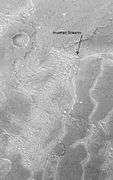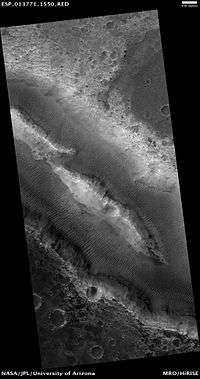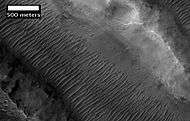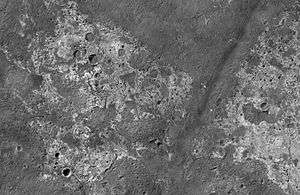Coprates quadrangle
|
Map of Coprates quadrangle from Mars Orbiter Laser Altimeter (MOLA) data. The highest elevations are red and the lowest are blue. | |
| Coordinates | 15°00′S 67°30′W / 15°S 67.5°WCoordinates: 15°00′S 67°30′W / 15°S 67.5°W |
|---|---|

The Coprates quadrangle is one of a series of 30 quadrangle maps of Mars used by the United States Geological Survey (USGS) Astrogeology Research Program. The Coprates quadrangle is also referred to as MC-18 (Mars Chart-18).[1] The Coprates quadrangle contains parts of many of the old classical regions of Mars: Sinai Planum, Solis Planum, Thaumasia Planum, Lunae Planum, Noachis Terra, and Xanthe Terra.
The Coprates quadrangle goes from 45° to 90° west longitude and 0° to 30° south latitude on Mars. Coprates quadrangle is famous for depicting the "Grand Canyon of Mars", the Valles Marineris Canyon System. Signs of water exist in this quadrangle, with ancient river valleys and networks of stream channels showing up as inverted terrain and lakes inside of Valles Marineris.[2]
Valles Marineris canyon system
Valles Marineris is the largest canyon system in the solar system; this great canyon would go almost all the way across the United States. The name for the whole system of canyons is Valles Marineris. Starting at the west with Noctis Labyrinthus in the Phoenicis Lacus quadrangle, the canyon system ends in the Margaritifer Sinus quadrangle with Capri Chasma and Eos Chasma (in the south). The word Chasma has been designated by the International Astronomical Union to refer to an elongate, steep-sided depression. Valles Marineris was discovered by and named for the Mariner 9 mission. Moving east from Noctis Labyrinthus, the canyon splits into two troughs, Tithonium Chasma and Ius Chasma (in the south). In the middle of the system are the very wide valleys of Ophir Chasma (north), Candor Chasma, and Melas Chasma (south). Going farther to the east, one comes to Coprates Chasma. At the end of Coprates Chasma, the valley gets wider to form Capri Chasma in the north and Eos Chasma in the south. The walls of the canyons often contain many layers. The floors of some of the canyons contain large deposits of layered materials. Some researchers believe that the layers were formed when water once filled the canyons.[2][3][4][5] The canyons are deep as well as long. In places they are 8-10 kilometers deep. Remember the Earth's Grand Canyon is only 1.6 kilometers deep.[6]
In a study published in the journal Geology in August 2009, a group of scientists led by John Adams of the University of Washington in Seattle proposed that Valles Marineris may have formed from a giant collapse when salts were heated up, thereby releasing water which rushed out carrying mud through underground plumbing. One point that supports this idea is that sulfate salts have been found in the area. These salts contain water which comes off when heated. Heat may have been generated by volcanic processes. After all, a number of huge volcanoes are nearby.[7] Other ideas have been advanced by others to explain the origin of the system.[2]
-
Map of Coprates quadrangle showing details of Valles Marineris, the largest canyon system in the solar system. Some of the canyons may have once been filled with water.
-
Melas Chasma, as seen by THEMIS. Click on image to see relationship of Melas Chasma to other features.
-
Cliff in Candor Chasma Plateau, as seen by THEMIS. Click on image to see relationship with other features in Coprates quadrangle.
-
Cliff in northern wall of Ganges Chasma, as seen by THEMIS. Click on image to see relationship with other features in the Coprates quadrangle.
Interior layered deposits and sulfate
Parts of the floors of Candor Chasma and Juventae Chasma contain layered deposits that have been termed interior layered deposits (ILD's) and Equatorial Layered Deposits (ELD's). These layers may have formed when the whole area was a giant lake. However, many other ideas have been advanced to explain them.[2] High-resolution structural and geologic mapping in west Candor Chasma, presented in March 2015, showed that the deposits on the floor of the Candor chasma are basin filling sediments that were deposited in a wet playa like setting; hence water was involved in their formation.[8]
Some places on Mars contain hydrated sulfate deposits, including ILD's. Sulfate formation involves the presence of water. The European Space Agency's Mars Express found possible evidence of the sulfates epsomite and kieserite. Scientists want to visit these areas with robotic rovers.[9]
These deposits have been found to contain ferric oxides in the form of crystalline grey hematite.[2][10][11]
Layers
Images of rocks in the canyon walls almost always show layers.[12] Some layers appear tougher than others. In the image below of Ganges Chasma Layers, as seen by HiRISE, one can see that the upper, light-toned deposits are eroding much faster than the lower darker layers. Some cliffs on Mars show a few darker layers standing out and often breaking into large pieces; these are thought to be hard volcanic rock instead of soft ash deposits. An example of hard layers is shown below in the picture of layers in the canyon wall in Coprates, as seen by Mars Global Surveyor. Because of its closeness to the Tharsis volcanic region, the rock layers may be made of layer after layer of lava flows, probably mixed with deposits of volcanic ash that fell out of the air following big eruptions. It is likely the rock strata in the walls preserve a long geological history of Mars.[13] Dark layers may be due to dark lava flows. The dark volcanic rock basalt is common on Mars. However, light-toned deposits may have resulted from rivers, lakes, volcanic ash, or wind blown deposits of sand or dust.[14] The Mars Rovers found light-toned rocks to contain sulfates. Probably having been formed in water, sulfate deposits are of great interest to scientists because they may contain traces of ancient life.[15] The Mars Reconnaissance Orbiter Compact Reconnaissance Imaging Spectrometer for Mars (CRISM) instrument found opaline silica in certain strata along and within the Valles Marineris canyon system.[16] Because Iron sulfates were sometimes found near the opaline silica, it is thought that the two deposits were formed with an acid fluid.[17]
-
Ganges Chasma Layers, as seen by HiRISE.
-
Layers in the canyon wall in Coprates, as seen by Mars Global Surveyor, under the MOC Public Targeting Program.
-

Wide view of layers in wall of Valles Marineris, as seen by HiRISE under HiWish program.
-

Close-up of layers in wall of Valles Marineris, as seen by HiRISE under HiWish program.
-

Part of wall of Valles Marineris, as seen by HiRISE under HiWish program.
-

Close-up of part of previous image of wall of Valles Marineris, as seen by HiRISE under HiWish program.
-

Layers in trough south of Ius Chasma, as seen by HiRISE under HiWish program
-

Close up of layers in trough south of Ius Chasma, as seen by HiRISE under HiWish program Note: this is enlargement of the previous image using HiView
-

Layers in Monument Valley. These are accepted as being formed, at least in part, by water deposition. Since Mars contains similar layers, water remains as a major cause of layering on Mars.
-
Layers west of Juventae Chasma, as seen by HiRISE. Scale bar is 500 meters long.
-
Orson Welles Crater, as seen by HiRISE. Layered, light-toned rocks seem to be under a dark mantling material. Layers may be sandstone, volcanic ash, or lakebed deposits.
-
Corprates Chasma Fault, as seen by HiRISE. Layers in the rock face may be from volcanic, lacustrine, and/or aeolian sediments deposited in Valles Marineris.
-
Ritchey Crater layers, as seen by HiRISE. The dark cap layer seems to be resistant to erosion, while the white middle layer is weak. Click on image to see more details. Scale bar is 500 meters long.
-
Two views of Melas Chasma Layered Deposits, as seen by HiRISE. Left picture lies north of other picture on the right. Pictures are not the same scale. Click on image to see details of layers.
-
Tithonium Chasma Layers, as seen by HiRISE.
-

Layers and dark dunes on the floor of a crater, as seen by HiRISE under the HiWish program. Groundwater may have risen up in the crater and cemented sediments with minerals.
-

Wide view of layers south of Ius Chasma, as seen by HiRISE under HiWish program
-

Close view of layers south of Ius Chasma, as seen by HiRISE under HiWish program Note: this is an enlargement of the previous wide view.
-

Close view of layers south of Ius Chasma, as seen by HiRISE under HiWish program Note: this is an enlargement of a previous wide view.
Herbes Chasma and hydrated deposits
Herbes Chasma, a large enclosed valley, may have once held water. Hydrated minerals have been found there. It is thought that large-scale underground springs of groundwater at different times burst to the surface to form deposits called Light Toned Deposits (LTD's). Some suggest present or fossilized life forms may be found there because the deposits are relatively young.[18]
Nirgal Vallis and sapping
Nirgal Vallis is one of the longest valley networks on Mars. It is so large that it is found on more than one quadrangle. Scientists do not know how all the ancient river valleys were formed. There is evidence that instead of rain or snow, the water that formed the valleys originated underground. One mechanism that has been advanced is sapping.[19] In sapping, the ground just gives away as water comes out. Sapping is common in some desert areas in America's Southwest. Sapping forms alcoves and stubby tributaries. These features are visible in the picture below of Nigal Vallis taken with Mars Odyssey's THEMIS.
Water from Nirgal Vallis contributed to a great flood that went though the rim of Holden Crater and helped form a lake in the crater. It's estimated that Nirgal Vallis had a discharge of 4800 cubic meters/second.[20] Water from Nirgal Vallis was inbounded in Uzboi Vallis because the rim of Holden Crater blocked the flow. At a certain point the stored water broke through the rim of Holden and created a lake 200–250 m deep.[21] Water with a depth of at least 50 m entered Holden at a rate that 5-10 times the discharge of the Mississippi River.[22][23][24][25] Terraces and the presence of large rocks (tens of meters across) support these high discharge rates.[21][22][26][27][28]
-
Nirgal Vallis that runs in two quadrangles has features looking like those caused by sapping. Picture taken with THEMIS.
Inverted relief
Some areas of Mars show inverted relief, where features that were once depressions, like streams, are now instead above the surface. These may have been formed when materials, like large rocks, were deposited in low-lying areas, then left behind after erosion (perhaps wind which can not move large rocks) removed much of the surface layers. Other ways of making inverted relief might be lava flowing down a stream bed or materials being cemented by minerals dissolved in water. On Earth, materials cemented by silica are highly resistant to all kinds of erosional forces. Inverted relief in the shape of streams are further evidence of water flowing on the Martian surface in past times. There are many examples of inverted channels near Juventae Chasma; some are shown in the image of Juventae Chasma below.[29][30][31]
-
Inverted Channels near Juventae Chasma, as seen by HiRISE. Channels were once regular stream channels. Scale bar is 500 meters long.
-

Inverted Streams near Juventae Chasma, as seen by Mars Global Surveyor. These streams begin at the top of a ridge then run together.
Vallis
Vallis (plural valles) is the Latin word for valley. It is used in planetary geology for the naming of landform features on other planets.
Vallis was used for old river valleys that were discovered on Mars, when probes were first sent to Mars. The Viking Orbiters caused a revolution in our ideas about water on Mars; huge river valleys were found in many areas. Space craft cameras showed that floods of water broke through dams, carved deep valleys, eroded grooves into bedrock, and traveled thousands of kilometers.[6][32][33]
-

Her Desher Vallis, as seen by HiRISE.
-

Her Desher Vallis close-up, as seen by HiRISE.
Craters
-

Crater showing layers and a bench, as seen by HiRISE under HiWish program
-

Close view of layers in crater, as seen by HiRISE under HiWish program
-

Wide view of crater showing dark dunes on floor and gullies on southern wall, as seen by HiRISE under HiWish program.
-

Close-up of dark dunes on floor of a crater, as seen by HiRISE, under HiWish program. Dunes are made up of basalt sand.
-

Lassell (Martian crater), as seen by CTX camera (on Mars Reconnaissance Orbiter).
Other features in the Coprates quadrangle
-
False color image of Candor Chasma showing locations of hydrated sulfate deposits, as seen by THEMIS. Red colors show rocky places. Greens and blues show sandy, dusty areas.
-

Channels in Candor plateau, as seen by HiRISE. Location is Coprates quadrangle. Click on image to see many small, branched channels which are strong evidence for sustained precipitation.
-
Melas Chasma Fluvial Channels, as seen by HiRISE. Click on image to see meandering and branching channels made with running water in the past.
-
Branching channels on floor of Melas Chasma. Image taken with THEMIS.
-

Ganges Mensa, as seen by HiRISE.
-
Capri Mensa, as seen by HiRISE. Click on image to see buttes and layers.
-
Ophir Chasma Wall, as seen by HiRISE.
-
Ius Chasma, as seen by HiRISE. Click on image to see layers.
-
Ius Chasma Floor Layers, as seen by HiRISE. Scale bar is 500 meters long.
-
Ius Chasma Mesa, as seen by HiRISE. Scale bar is 500 meters long.
-

Channels near the rim of Ius Chasma, as seen by HiRISE. The pattern and high density of these channels support precipitation as the source of the water. Location is Coprates quadrangle.
-
Juventae Chasma Troughs, as seen by HiRISE.
-
Channels West of Echus Chasma. The fine pattern of branching stream beds were probably formed from water moving across the surface. Image taken with THEMIS.
-
Dendritic channels on mesa of Echus Chasma. Image is 20 miles wide. Image taken with THEMIS.
-

Part of wall of Valles Marineris, as seen by HiRISE under HiWish program.
-

Close-up of part of previous image of wall of Valles Marineris, as seen by HiRISE under HiWish program.
-

Landslide in a trough just south of Ius Chasma, as seen by HiRISE under HiWish program
Other Mars quadrangles
Interactive Mars map
See also
References
- ↑ Davies, M.E.; Batson, R.M.; Wu, S.S.C. "Geodesy and Cartography" in Kieffer, H.H.; Jakosky, B.M.; Snyder, C.W.; Matthews, M.S., Eds. Mars. University of Arizona Press: Tucson, 1992.
- 1 2 3 4 5 Cabrol, N. and E. Grin (eds.). 2010. Lakes on Mars. Elsevier. NY
- ↑ McCauley, J. 1978. Geologic map of the Coprates quadrangle of Mars. U.S. Geol. Misc. Inv. Map I-897
- ↑ Nedell, S.; et al. (1987). "Origin and evolution of the layered deposits in the Valles Marineris, Mars". Icarus. 70: 409–441. Bibcode:1987Icar...70..409N. doi:10.1016/0019-1035(87)90086-8.
- ↑ Weitz, C. and T. Parker. 2000. New evidence that the Valles Marineris interior deposits formed in standing bodies of water. LPSC XXXI. Abstract 1693
- 1 2 Hugh H. Kieffer (1992). Mars. University of Arizona Press. ISBN 978-0-8165-1257-7. Retrieved 7 March 2011.
- ↑ "Mars Canyon Formed When Plug Was Pulled, Study Suggests". Space.com. 2009-08-25. Retrieved 2012-08-18.
- ↑ Okubo, C. 2015. HIGH-RESOLUTION STRUCTURAL AND GEOLOGIC MAPPING IN CANDOR CHASMA. 46th Lunar and Planetary Science Conference. 1210.pdf
- ↑ "Bath Salts in Candor Chasma? | Mars Odyssey Mission THEMIS". Themis.asu.edu. Retrieved 2012-08-18.
- ↑ Christensen, P.; et al. (2001). "Global mapping of Martian hematite mineral deposits: Remnants of water-driven processes onearly Mars". J. Geophys. Res. 106: 23873–23885. Bibcode:2001JGR...10623873C. doi:10.1029/2000je001415.
- ↑ Weitz, C.; et al. (2008). "Gray hematite distribution and formation in Ophir and Candor Chasmata". J. Geophys. Res. 113: E02016. Bibcode:2008JGRE..113.2016W. doi:10.1029/2007je002930.
- ↑ Grotzinger, J. and R. Milliken. 2012. Sedimentary Geology of Mars. SEPM.
- ↑ "Landslides and Debris in Coprates Chasma | Mars Odyssey Mission THEMIS". Themis.asu.edu. Retrieved 2012-08-18.
- ↑ "HiRISE | Light-toned Layers in Eos Chaos (PSP_005385_1640)". Hirise.lpl.arizona.edu. Retrieved 2012-08-18.
- ↑ http://hirise,lpl.arizona.edu/PSP_007430_1725[]
- ↑ Murchie, S. et al. 2009. A synthesis of Martian aqueous mineralogy after 1 Mars year of observations from the Mars Reconnaissance Orbiter. Journal of Geophysical Research: 114.
- ↑ Milliken, R. et al. 2008. Opaline silica in young depsoits on Mars. Geology: 847-850
- ↑ May Have Played Important Role in Shaping Mars
- ↑ http://themis.asu.edu/zoom-20030916a
- ↑ Irwin, J., R. Craddock, R. Howard. 2005. Interior channels in Martian valley networks: Discharge and runoff production. Geology: 33,489-492.
- 1 2 Grant, J., R. Irwin, S. Wilson. 2010. Aqueous depositional settings in Holden crater, Mars In Cabrol, N. and E. Grin (eds.). 2010. Lakes on Mars. Elsevier. NY.
- 1 2 Grant, J., T. Parker. 2002. Drainage evolution of the Margaritifer Sinus region, Mars. J. Geophysic. Res. 107, doi:10.1029/2001JE001678.
- ↑ Komar, P. 1979. Comparisons of the hydraulics of water flows in Martian outflow channels with flows of similar scale on Earth. Icarus: 37, 156-181.
- ↑ Grant, J. et al. 2008. HiRISE imaging of impact megabreccia and sub-meter aqueous strata in Holden Crater, Mars. Geology: 36, 195-198.
- ↑ Irwin, et al. 2005. An intense terminal epoch of widespread fluvial activity on early Mars: 2. Increased runoff and paleolake development. J. Geophysical. Res. 110, E12S14, doi: 10.1029/2005JE002460.
- ↑ Boothroyd, J. 1983. Fluvial drainage systems in the Ladon Basin area: Margaritifer Sinus area, Mars. Geol. Soc. Am. Abstr. Programs 15, 530
- ↑ Grant, J. 1987. The geomorphic evolution of Eastern Margaritifer Sinus, Mars. Adv. Planet. Geol. NASA Tech memo. 89871, 1-268.
- ↑ Parker, T. 1985. Geomorphology and geology of the southwestern Margaritifer Sinus-northern Argyre region of Mars, California State University, M. S. Thesis, Los Angeles, California
- ↑ "HiRISE | Inverted Channels North of Juventae Chasma (PSP_006770_1760)". Hirise.lpl.arizona.edu. Retrieved 2012-08-18.
- ↑ Malin, M., et al. 2010. An overview of the 1985-2006 Mars Orbiter Camera science investigation. http://marsjournal.org
- ↑ "Icarus | Vol 221, Iss 1, In Progress , (September–October, 2012)". ScienceDirect.com. Retrieved 2012-08-18.
- ↑ Raeburn, P. 1998. Uncovering the Secrets of the Red Planet Mars. National Geographic Society. Washington D.C.
- ↑ Moore, P. et al. 1990. The Atlas of the Solar System. Mitchell Beazley Publishers NY, NY.
- 1 2 Morton, Oliver (2002). Mapping Mars: Science, Imagination, and the Birth of a World. New York: Picador USA. p. 98. ISBN 0-312-24551-3.
- ↑ "Online Atlas of Mars". Ralphaeschliman.com. Retrieved December 16, 2012.
- ↑ "PIA03467: The MGS MOC Wide Angle Map of Mars". Photojournal. NASA / Jet Propulsion Laboratory. February 16, 2002. Retrieved December 16, 2012.
- ↑ "Online Atlas of Mars". Ralphaeschliman.com. Retrieved December 16, 2012.
- ↑ "PIA03467: The MGS MOC Wide Angle Map of Mars". Photojournal. NASA / Jet Propulsion Laboratory. February 16, 2002. Retrieved December 16, 2012.
External links
| Wikimedia Commons has media related to Coprates quadrangle. |
- Flying around Candor Chasma at an altitude of 100 meters
- Lakes on Mars - Nathalie Cabrol (SETI Talks)
| Quadrangles on Mars | ||||||||||||||||||||||||||||||||||||||||||||||||||||||||||||||||||||||||||||||||||||||||||||||||||||||||||||||||||||||||||||||||||||||||||||||||
|---|---|---|---|---|---|---|---|---|---|---|---|---|---|---|---|---|---|---|---|---|---|---|---|---|---|---|---|---|---|---|---|---|---|---|---|---|---|---|---|---|---|---|---|---|---|---|---|---|---|---|---|---|---|---|---|---|---|---|---|---|---|---|---|---|---|---|---|---|---|---|---|---|---|---|---|---|---|---|---|---|---|---|---|---|---|---|---|---|---|---|---|---|---|---|---|---|---|---|---|---|---|---|---|---|---|---|---|---|---|---|---|---|---|---|---|---|---|---|---|---|---|---|---|---|---|---|---|---|---|---|---|---|---|---|---|---|---|---|---|---|---|---|---|---|
| ||||||||||||||||||||||||||||||||||||||||||||||||||||||||||||||||||||||||||||||||||||||||||||||||||||||||||||||||||||||||||||||||||||||||||||||||


